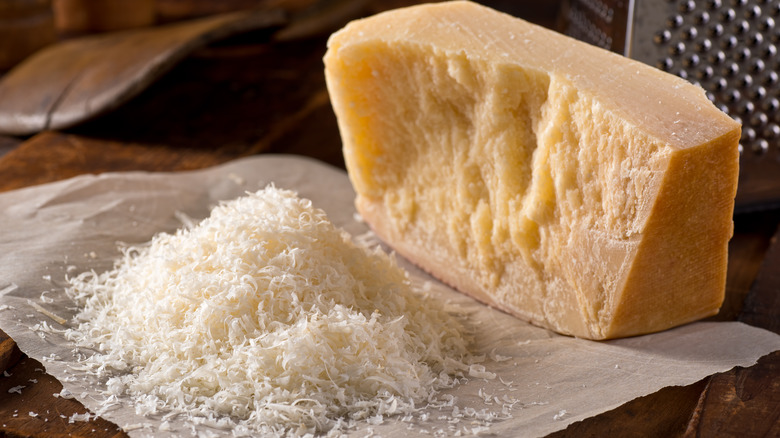Microplane Vs Box Grater: Which Gets The Most Out Of Your Cheese?
Once you've chosen the right cheese for your pasta, it's time to figure out the best way to actually get it onto your plate for a nice and cheesy meal. Between the sleek and popular microplane and all the different sides of a box grater, there are quite a few options to consider. However, when it really comes down to it, the best way to get the most out of your grated cheese really depends on the kind of cheese and what exactly you're using it for.
Despite what you might think, it actually has less to do with flavor and more to do with practicality. Microplanes are handy, convenient tools that produce delicate and fine particles, making them perfect for grating a feathery topping of cheeses to melt in your mouth right away. On the other hand, a box grater has a wider range of sizes into which it can break down cheese. It might also be the more efficient tool to use when grating a large amount of cheese to incorporate into sauces.
When is a microplane best for grating cheese?
Precise, convenient, and easy to clean, microplanes are a popular kitchen tool that even celebrity chefs consider essential. They make one of the best zesters you can get your hands on, never mind being the best tool for grating fresh spices like nutmeg, ginger, and garlic.
It might come as no surprise that cheese is no exception to its versatile repertoire. In fact, it might be much better at grating hard cheeses than the finest, puckered side of a box grater ever will. By most accounts, grating parmesan or pecorino on a microplane yields a fluffy, feathery cloud of cheese that not only looks great on top of pasta or other dishes but gives a delicate mouthfeel alongside the subtle sharpness of the aged cheese.
On the flip side, they're unfortunately as terrible at grating softer cheeses as the smaller sides of a box grater. Even semi-soft cheeses like cheddar or mozzarella will likely leave you frustrated as they crumble and clog up the fine teeth of the microplane. If you would really like a handheld tool for softer cheeses instead of relying on the bulky box grater, you should probably get the more coarse, grater-sized models of a microplane. A handheld cheese grater is another solid option, too.
When is a box grater best for grating cheese?
Ultimately, if you absolutely have to choose between a tool for the specific purpose of grating cheese, you should go with a classic box grater. While it's not as good as making soft shavings of hard cheese, it's still capable of doing so while also giving you the option for grating softer cheeses.
Not to mention, the varied sizes give you more options when controlling the size of your cheese shavings, depending on the occasion. Also, it's much more efficient when it comes to grated cheese that doesn't need to be visually appealing at first brush. Dishes like baked pasta and casseroles are best handled with a box grater rather than unnecessarily struggling with a microplane to get enough cheese grated.
Furthermore, microplanes can result in grainier cheese-based sauces. For some reason, box graters produce cheese that's able to emulsify into sauce much more smoothly than microplanes do. In summary, microplanes are better for grating hard cheeses into a delicate topping, while box graters are better for nearly every other reason you'd have to grate cheese.
Subsequently, the box grater is the more versatile tool to have. Though, it's worth mentioning that microplanes are typically pretty affordable and very easy to keep on hand as a supplemental tool. If you're a cheese lover, home chef, or both, you may want to have both in your kitchen.


